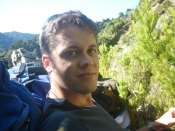Hacking places with historical sound walks
I find it easy for history teaching to become an abstract process confined to the limits of the classroom walls. At its best, the classroom can be a place of enriching intellectual development and the exhilaration that always comes with any profound shift in the way we look at the world. But history isn't usually made in the classroom. In the last two years I have been exploring ways to regularly take my teaching outside and into the streets of Wellington, explicitly trying to build the links between classroom learning and the places of the past right outside the classroom door. I have come to think of this as giving students the tools to 'hack' the history behind everyday places.
To do this I have used a technique with my students called an historical sound walk. I define this as an evidence-based tour around a particular location that actively uses combinations of the physical surroundings, pre-existent historical interpretations, contemporary ambient sounds and thoughts from people living, working or passing through a particular location. These features, in tight combination with sources, are used to construct a judgment of historical significance that actively draws the listener in to experiencing a place in new ways. The sound walk is recorded in MP3 format and uploaded to a public website. A true sound walk has to be recorded at the site and can only be fully experienced if listened to at the intended location.
How do students determine the historical significance of a place? Initially I encouraged them to use Christine Counsell's '5Rs', a set of disciplinary-based criteria. After some experimenting with this I found it led students to a focus on events, whereas I wanted them to also consider the historical significance of places, even if, as one student put it, "nothing happened there". I developed a set of place-based "geo-historical' criteria that I thought would help students explore how certain locations become part of the tapestry of society, and are caught up in complicated power relations and practices of use. These experimental criteria are:
Power – It is a place which reveals power relations in society. Its meaning for some people might have been silenced or marginalized in the past. Perhaps some people felt or continue to feel a sense of belonging there while others are excluded.
Legendary – The place is ‘storied’. People tell legends there and it is used to sustain myths.
Affected by change – The place has changed over time, either physically or in terms of how it is used or viewed.
Contested and connected – The place is argued over and is or was a source of debate. People may feel a strong sense of connection to it, often for different reasons.
Evocative – The place is one where you can ‘feel’ history.
Bradshaw identifies a basic model teachers can use to anticipate students' progress in their understanding of significance. He suggests students start with using criteria, move to identifying criteria, then create their own criteria and at the highest level, use criteria to either challenge or support judgments of historical significance implicit within historical accounts. Naturally, the linear nature of this model is deceptive. Rarely does a student's thinking conform exactly to progression models. However, the first class I attempted sound walks with did not move further than the first step and I knew they were capable of more.
This year some students have done a fantastic job challenging interpretations of significance made at their chosen place, although I overcompensated and didn't focus enough on helping them to explicitly use and recognize criteria. Next year I plan to drop the use of Counsell's 5Rs and use a combination of my PLACE mnemonic and Seixas and Morton's simple criteria: had consequences and reveals something about the past.
Many students started to develop aspects of their historical thinking other than historical significance as they explored the history of their place. While this can work, I strongly feel that historical sound walks are a particularly powerful way for students to learn and to teach their listeners about historical significance. The Wellington Museum of City & Sea has agreed to put information about students' work in their pamphlet holders. My hope is that young people will play an active role in educating Wellingtonians about the history beneath their feet and how it is encoded into the buildings, memories and memorials all around them.
References
Bradshaw, M. (2006), Creating controversy in the classroom: making progress with historical significance in Teaching History, 125.
Counsell, C. (2005), Looking through a Josephine-Butler window: focusing pupils’ thinking on historical significance, in Teaching History, 114.


